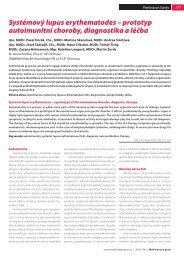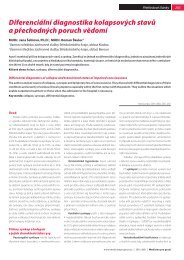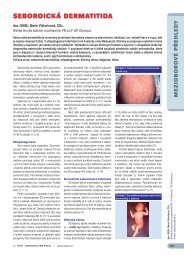OtevÅÃt - MedicÃna pro praxi
OtevÅÃt - MedicÃna pro praxi
OtevÅÃt - MedicÃna pro praxi
Create successful ePaper yourself
Turn your PDF publications into a flip-book with our unique Google optimized e-Paper software.
MEZIOBOROVÉ PŘEHLEDY<br />
Obrázek 8. Detail pozitivní reakce v epikutánním<br />
testu<br />
odečítání a zejména zkušenosti s hodnocením reakcí<br />
a interpretací výsledků. Proto doporučujeme tuto<br />
techniku svěřit erudovanému dermatologovi, který<br />
se touto <strong>pro</strong>blematikou zabývá.<br />
Léčba KD se neliší od ostatních dermatitid,<br />
základním předpokladem je odstranění zjevných<br />
i možných (potenciálních) příčin iritace, šetrné odstranění<br />
alergenů z kůže. Nezbytné je dodržovat<br />
zásady fyziologického čištění kůže, používat regenerační<br />
<strong>pro</strong>středky, bariérové krémy a ochranné<br />
pomůcky. K preventivnímu ošetřování vysušené,<br />
drsné a popraskané kůže jsou vhodné mastné krémy<br />
typu v/o. Nemocnou kůži je dále nutno ochránit<br />
před dráždivými nespecifickými vlivy, jako jsou další<br />
detergenty, sluneční záření, chlad či sálavé teplo,<br />
pocení, zapaření pod obvazy nebo mastmi. Většinou<br />
vystačíme s lokální léčbou. Plně indikovány jsou<br />
lokální kortikosteroidy, avšak jejich výběr musí být<br />
podřízen klinickému obrazu a její lokalizaci. Na akutní<br />
dermatitidy se používají spreje, pěny a roztoky, na<br />
subakutní <strong>pro</strong>jevy krémy a masti. Neopomíjíme ani<br />
klasické léky, zejména různé druhy obkladů, např.<br />
z hypermanganu, borové vody či Jarischova roztoku.<br />
Některé druhy dermatitid vyžadují zevní léčiva<br />
s antibakteriální přísadou. Chronické <strong>pro</strong>jevy vyžadují<br />
spíše masťové základy nebo pasty s kyselinou<br />
salicylovou, močovinou, dehtem aj. Celková terapie<br />
tlumí především svědění, nejčastěji s pomocí antihistaminik.<br />
Pouze výjimečně používáme na krátkou<br />
dobu kortikosteroidy celkově v počáteční dávce nepřesahující<br />
40 mg Prednisonu.<br />
Jen ve zcela ojedinělých případech dojde časem<br />
k vyhasnutí alergie, bohužel u většiny pacientů<br />
trvá jednou vzniklá alergie celoživotně. Jedinou<br />
možnou prevencí recidiv dermatitidy je tedy přísná<br />
ochrana před jakýmkoliv kontaktem s alergenem.<br />
Nemocného je nutné stručně poučit o principech<br />
alergie, vybavit pacienta alergologickým průkazem<br />
se všeobecným poučením o principech kontaktní<br />
alergie.<br />
Podporováno VZ FNM č. MZO 00064203/6904.<br />
MUDr. Alena Machovcová, MBA<br />
Dermatovenerologické oddělení FN v Motole<br />
V Úvalu 84, 150 06 Praha 5<br />
e-mail alena.machovcova@fnmotol.cz<br />
Literatura<br />
1. Akyol A, Boyvat A, Peksari Y, Gürgey E. Contact sensitivity to standard series allergens in 1038<br />
patients with contact dermatitis in Turkey. Contact Dermatitis 2005; 52: 333–337.<br />
2. Basketter DA, Angelini G, Ingber A, Kern PS, Menné T. Nickel, chromium and kobalt in consumer<br />
<strong>pro</strong>ducts: revising safe levels in the new millenium. Contact Dermatitis 2003; 49: 1–7.<br />
3. Brasch J, Geier J, Gefeller O. Dynamic patterns of allergic patch test reactions 10 European<br />
standard allergens. Contact Dermatitis 1996; 35: 17–22.<br />
4. Bruynzeel DK, Andersen KE, Camara JG, Lachapelle JM, Menné T, White IR. The European<br />
standard series. Contact Dermatitis 1995; 33: 145–148.<br />
5. Bruynzell DP, Diepgen TL, Andersen KE, Brandăo FM, Brunze M, Frosch PJ, Goossens A, Lahti<br />
A, Mahler V, Maibach HI, Menné T, Wilkinson JD. Monitoring the European standard series in 10<br />
centres 1996-2000. Contact Dermatitis 2005; 53: 146–152.<br />
6. Buckley DA, Rycroft RJG, White IR, McFadden JP. The frequency of fragrance allergy in patchtested<br />
patiens increases with thein age. Br J Dermat 2003; 149: 986–989.<br />
7. Dastychová E, Semrádová V. Frekvence kontaktní senzibilizace na alergeny Evropské standardní<br />
sady Trolab u ekzematiků v letech 1997–1999. Čes. slov. Derm. 2000; 75(5): 219–229.<br />
8. Frosch PJ, Menné T, Lepoittevin J-P, (eds). Contact dermatitis. 4 th ed. Berlin: Springer-<br />
Verlag, 2006.<br />
9. Frosch PJ, Pilz B, Andersen KE, Burrows D, Camarasa JG, Dooms-Goossens A, Ducombs G,<br />
Fuchs T, Hannuksela M, Lachapelle JM, Lahti A, Maibach HI, Menné T, Rycroft RJG, Shaw S,<br />
Wahlberg JE, White IR, Wilkinson JD. Patch testing with fragrances: results of a multicenter study<br />
of the European Environmental and Contact Dermatitis Research Group with 48 frequently used<br />
constituents of perfumes. Contact Dermatitis 1995; 33: 333–342.<br />
10. Hasan T, Rantanen T, Alanko K, Harvima RJ, Jolanki R, Kalimo K, Lahti A, Lammintausta K,<br />
Lauerma AI, Laukkanen A, Luukkaala T, Riekki R, Turjanmaa K, Varjonen E, Vuorela AM. Patch<br />
test reactions to cosmetic allergens in 1995–1997 and 2000–2002 in Finland – a multicentre study.<br />
Contact Dermatitis 2005; 53: 40–45.<br />
11. Hussain I, Rani Z, Rashid T, Haroon TS. Suitability of the European standard series of patch<br />
test allergens in Pakistani patients. Contact Dermatitis 2002; 46: 50–51.<br />
12. Isakson M, Brandăo FM, Brunze M, Goossens A. Recommmendation to include budesonide<br />
and tixocortol pivalate in the European standard series. Contact Dermatitis 2000; 43: 41–42.<br />
13. Kashani MN, Gorouhi F, Behnia F, Nazemi MJ, Dowlati Y, Firooz A. Allergic contact dermatitis<br />
in Iran. Contact Dermatitis 2005; 52: 154–158.<br />
14. Lachapelle JM, Maibach H I. Patch testing and prick testing. A practical guide. Berlin, Heidelberg,<br />
New York: Springer, 2003.<br />
15. Lestringant GG, Bener A, Sawaya M, Galadari IH, Frossard PM. Allergic contact dermatitis in<br />
the United Arab Emirates. Int J Dermatol 1999; 38: 181–186.<br />
16. Liu YQ, Zhao B, Zhuang LH, Fan WX. Patch test reactions to the Chinese Standard Screening<br />
Allergens in 1,135 patients investigated for allergic contact dermatitis. Am J Contact Dermat<br />
1997; 8(3): 141–143.<br />
17. Machovcova A, Dastychova E, Kostalova D, Vojtechovska A, Reslova J, Smejkalova D, Vaneckova<br />
J, Vocilkova A. Common contact sensitizers in the Czech Republic. Patch test results in<br />
12,058 patients with suspected contact dermatitis. Contact Dermatitis 2005; 53: 162–166.<br />
18. Machovcová A. Rozbor kontaktní alergie na některé nedeklarované součásti zevních léků<br />
u pacientů s bércovým vředem a/nebo s varikózní a mikrobiální dermatitidou bérců. Čs. Derm.<br />
1999; 74(1): 3–10.<br />
19. Marks Jr. JG, Belsito DV, DeLeo VA, Fowler JF, Fransway AF, Maibach HI, Toby Mathias CG,<br />
Nethercott JR, Rietschel RL, Sherertz EF, Storrs FJ, Taylor JS. North American Contact Dermatitis<br />
Group patch test results for the detection of delayed-type hypersensitivity to topical allergens.<br />
J Am Acad Dermatol 1998; 38: 6(1): 911–918.<br />
20. Marks Jr. JG, Elsner P, DeLeo VA. Contact & Occupational Dermatology. 3 rd ed. St. Louis:<br />
Mosby, 2002.<br />
21. Modjtahedi BS, Modjtahedi SP, Maibach HI. The sex of the individual as a factor in allergic<br />
contact dermatitis. Contact Dermatitis 2004; 50: 53–59.<br />
22. Rietschel RL, Fowler Jr. JF. Fisher’s Contact dermatitis. 5 th ed. Philadelphia, USA: Lippincott<br />
Williams & Wilkins, 2001.<br />
23. Schnuch A, Lessmann H, Geier J, Frosch PJ, Uter W. Contact allergy to fragrances: frequencies<br />
of sensitization from 1996 to 2002. Results of the IVDK. Contact Dermatitis 2004; 50: 65–76.<br />
24. Signhal V, Reddy BS. Common contact sensitizers in Delhi. J Dermatology 2000; 27(7):<br />
440–445.<br />
25. Urbanček S, Dastychová E, Buchvald D, Vocilková A. Kontaktné alergeny v pracovnom a životnom<br />
<strong>pro</strong>středí. Banská Bystrica: Polygrafia Gutengerg, 2005.<br />
26. Uter W, Hegewald J, Aberer W, Ayala F, Bircher AJ, Brasch J, Coenraads PJ,, Schuttelaar<br />
M-LA, Elsner P, Fartasch M, Mahler V, Belloni Fortina A, Frosch PJ, Fuschs T, Johansen JD, Menné<br />
T, Jolanki R, Krecisz B, Kiec-Swierczynska M, Larese F, Orton D, Peserico A, Rantanen T,<br />
Schnuch A. The European standard series in 9 European countries, 2002/2003 – First results of<br />
the European Surveillance System on Contact Allergies. Contact Dermatitis 2005; 53: 136–145.<br />
27. Uter W, Pfahlberg A, Gefeller O, Geier J, Schnuch A. Risk factors for contact allergy to nickel –<br />
result of a multifactorial analysis. Contact Dermatitis 2002; 48: 33–38.<br />
28. Wöhrl S, Hemmer W, Focke M, Götz M, Jarisch R. Patch testing in Children, Adults, and the<br />
Elderly: Influence of Age and Sex on Sensitization Patterns. Pediatric Dermatology 2003; 20(2):<br />
119–123.<br />
29. Wöhrl S, Hemmer W, Focke M, Götz M, Jarisch R. The significance of fragrance mix, balsam<br />
of Peru, colophony and <strong>pro</strong>polis as screening tools in the detection of fragrance allergy. Br J Dermat<br />
2001; 145: 268–273.<br />
330<br />
www.medicina<strong>pro</strong><strong>praxi</strong>.cz / MEDICÍNA PRO PRAXI 2008; 5(9)
















